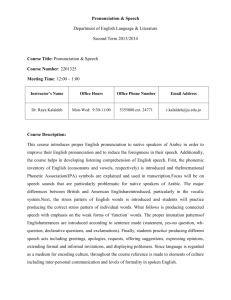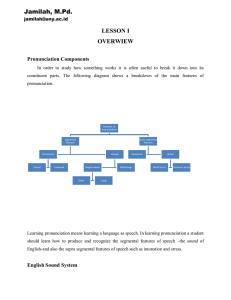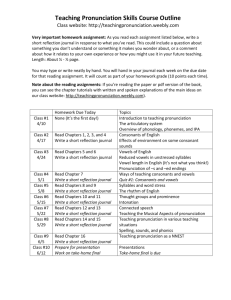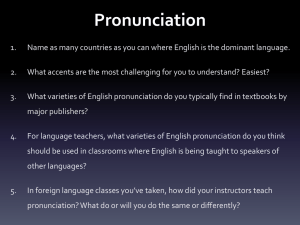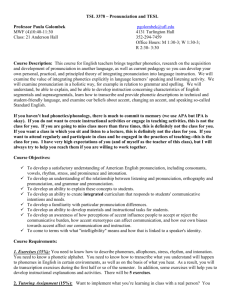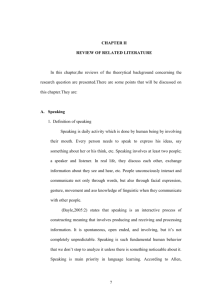Pronunciation and Speech_Syllabus_s2012
advertisement
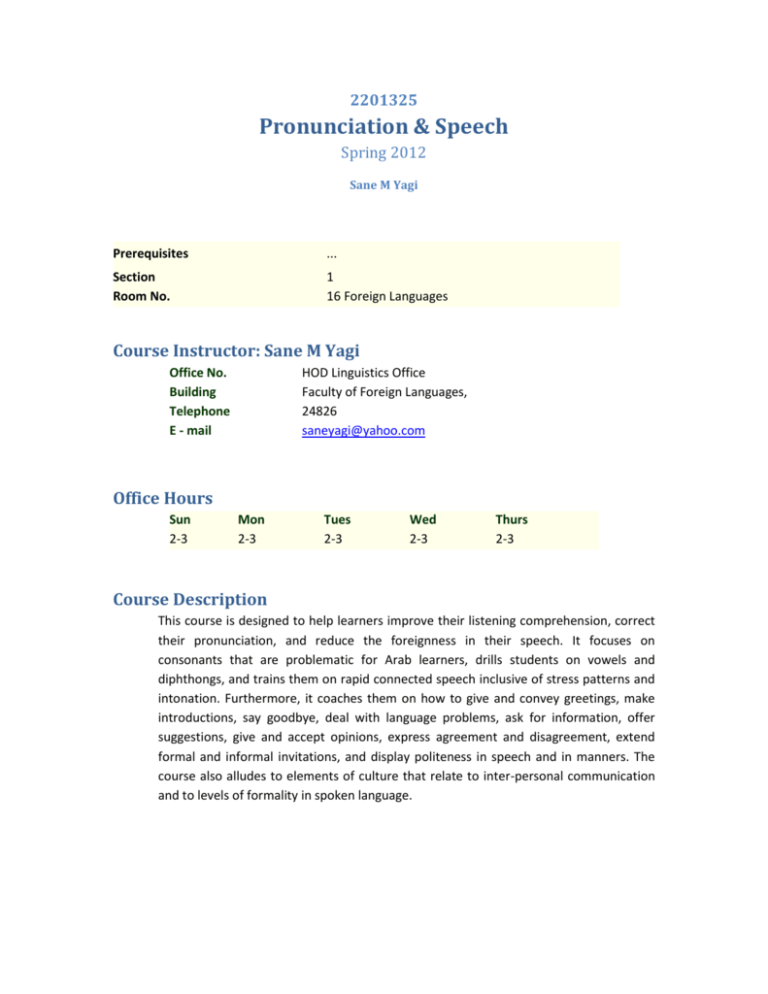
2201325 Pronunciation & Speech Spring 2012 Sane M Yagi Prerequisites ... Section Room No. 1 16 Foreign Languages Course Instructor: Sane M Yagi Office No. Building Telephone E - mail HOD Linguistics Office Faculty of Foreign Languages, 24826 saneyagi@yahoo.com Office Hours Sun 2-3 Mon 2-3 Tues 2-3 Wed 2-3 Thurs 2-3 Course Description This course is designed to help learners improve their listening comprehension, correct their pronunciation, and reduce the foreignness in their speech. It focuses on consonants that are problematic for Arab learners, drills students on vowels and diphthongs, and trains them on rapid connected speech inclusive of stress patterns and intonation. Furthermore, it coaches them on how to give and convey greetings, make introductions, say goodbye, deal with language problems, ask for information, offer suggestions, give and accept opinions, express agreement and disagreement, extend formal and informal invitations, and display politeness in speech and in manners. The course also alludes to elements of culture that relate to inter-personal communication and to levels of formality in spoken language. Course Goals This course aims to get students to • • • • • Identify the individual English consonant and vowel sounds. Produce the individual consonant and vowel sounds in the English language. Match the IPA symbols to native speaker-recorded consonants and vowels. Use stress and intonation patterns correctly. Relate spelling patterns to the pronunciation of sounds. Course Outcomes By the end of this Pronunciation and Speech course, students shall be able to Knowledge • List the contexts for rising and falling intonation. • Recall the phonetic symbols correctly. Comprehension • • • • • • • Describe the contexts of use for a variety of speech formulas. Recognize incorrect pronunciation. Explain mistakes in articulation. Express active interest in imitating native speaker speech. Tell where various consonants and vowels are produced. Correctly identify vowels in connected speech. Identify stress and intonation patterns in spoken English. Application • Articulate English consonants, vowels, and diphthongs correctly. • Apply the rules for correctly pronouncing the plural/possessive/3rd person singular <s> and the three past “ed” sounds. • Overcome the Arab problematic pronunciation of the affricates, the voiced palatal fricative, the flap, the voiced palatal liquid, the voiceless bilabial stop, as well as the cardinal vowels, the lax vowels, and the various diphthongs. Analysis • Analyze speaker intentions and respond appropriately. • Match spelling-problematic words with correct pronunciation. Synthesis • Modulate sound articulation in accordance with stress and intonation patterns. • Make correct self introductions and introduce others. • Welcome visitors and indulge in small talk. • Have cordial exchanges with others. • Solicit information in culturally appropriate ways. • Seek clarification and clear communication problems. • Agree and disagree with others in non-confrontational manners. Evaluation • Judge the accuracy of the speech of others. • Evaluate their own speech. • Assess the appropriateness of speech formulas to the context of use. Syllabus W Topic Reference/ Assignment eek 1 2 3 4 5 6 7 8 9 10 11 12 13 14 15 Meetings and Greetings Stop Sounds Hello and Goodbye Fricative Sounds Some Polite Remarks, Please and Thank You Front Vowels Apologies Back Vowels Questions and Answers Central Vowels Agreement and Disagreement Diphthongs Conversational Openings: Questions and Remarks Consonantal Clusters Expressing Opinions Minimal Pairs Requests, Invitations, and Suggestions Speech Acts Trouble Speech Acts Sympathy and Consolation Speech Acts Exclamations Tongue Twisters On the Phone Tongue Twisters Pronunciation Stress and Weak Forms Assessment Soliya Participation 10% Throughout the course Test 1 20% Wed. 7/3/2012 Test 2 20% Wed. 11/4/2012 Final Exam 50% Wed. 16 /5/2012 @ 12.00-3.00 Textbooks Egle, Mandy. (2011). Pronunciation Pages: Sounds of American English. Seattle: Seattle Learning Academy. ISBN: 0985559942, 9780985559946. Binham, P. (1968). How to Say It. Harlow, England: Longman. J.D. O’Connor. (1980). Better English Pronunciation (2nd Ed.). Cambridge: Cambridge University Press. ISBN: 978-0-521-23152-7. Course Resources University of Iowa Phonetics Training: http://www.uiowa.edu/~acadtech/phonetics/english/frameset.html Ellis Master Pronunciation Software www.formavision.com Soliya soliya.mit.edu Soliya Help Desk: students@soliya.net



